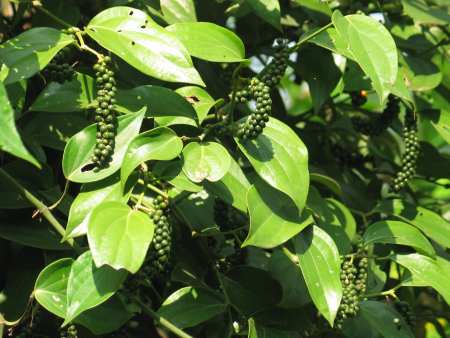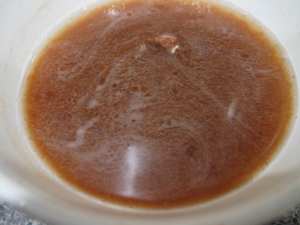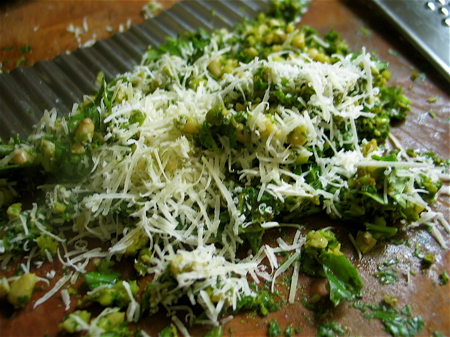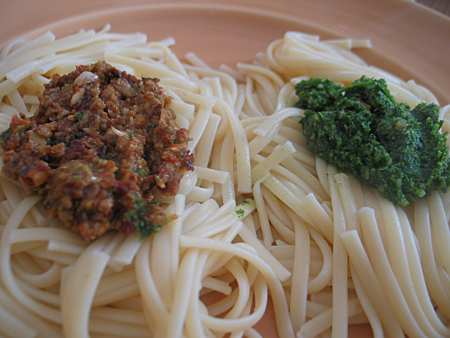
This picture was taken during my last visit to Kerala. Not the best picture but good enough to appreciate the lovely beaded pepper. What made me bring this picture out is the ‘ The Spice is Right’ food event, hosted by Barbara of Tigers and Strawberries. Black pepper needs no introduction. Well known, well loved, black pepper is a regular item in every pantry.
Black pepper is grown as a cash crop in Kerala, my homestate. This was a major source of income for most Kerala farmers. Nowadays, due to the high costs of farming,people have turned to other economical crops or totally given up farming. When my grandfather was alive, he used to be incharge of these peppers that would spread like a vine onto trees..almost everytree in the plot had a blackpepper vine hugging it. When they flower and bear fruit, they are the most beautiful things to look at..perfect round globes arranged in perfect symmetry around one long spike. When they ripen, they assume a shade of red. The person who plucks these peppers are a sight to watch. They carry long ladders made of bamboo and have a sack around their waist to collect the peppers. I was allowed to pluck the peppers from the lower parts of the plants and that is the way I used to collect my pocket money during my vacation.
Once they are collected, they are made to seperate from the small twig that bears them by crushing them under the feet. I used ‘crushing’ for lack of a better term. They are king of churned slowly under your feet and they seperate from the spike to which they are attached. I think we wilt them under the sun before this process so that the skin doesn’t get damaged. Then they are dried under the sun, where they get the black look and hence the term ‘black pepper’. It is amazing how much less these dried ones weigh compared to the freshpicked berries. If you pluck a whole sack of these, once dried and when ready to use they might yield, maybe a quarter of their original weight. I used to be so dismayed at this when I was a kid and felt so cheated. Once they are dried, they are tied in sacks and kept away for future use. Noone I knew ever bouught black pepper in stores, they were always stored in the dark store room and when relatives visited from other states, they always left with a big bag of these.
For more on black pepper , click here

Now for a recipe that highlights pepper, the first thing that comes to my mind is a garlic and pepper rasam that I had at my brother-in-law’s home. I made a quick call to my sister but couldnt get through to her. I have made rasam only one time before and so I had to look up a recipe somewhere, and I found one in this book. The book had a black pepper rasam with tamarind which I followed closely. I added some garlic to this recipe and it was very close to the one I tasted at my brother-in-laws house.
Recipe
1 tsp coriander seeds
1/2 tsp black mustard seeds
1/2 tsp cumin seeds
1/2 tsp whole black pepper
3/4 tablespoons urad dal
2whole dried red chiles
1 tbsp veg oil
Add the oil to a hot pan and add the above ingredients to the oil. The mustard seeds will splutter and the cumin and urad dal starts turning brown. Be ready to be bowled over by the fragrance of the spices roasting in the oil. Keep a close eye on them and remove when they start turning brown, maybe a min or so.
Let it cool to room temp. and grind them using a mortar and pestle. ( The original recipe suggests grinding it to a powder) I just ground them coarsely.

Step two: Making tamarind extract

Take a small size piece of tamarind and place it in a bowl of warm water. Use your hands to extract the juice from the tamarind. It yields a browncolored liquid. This is the tamarind water that lends the sour taste to the rasam.
( Alternatively use a tsp of tamarind concentrate)
Final assembly
Oil 1/2 tablespoon
Mustard seeds 1/2 tablespoon
Garlic cloves 2 crushed
Curry leaves 3 or 4
Coriander leaves to garnish
Salt to taste
To a saucepan over medium heat, add oil and add mustard seeds to the hot oil. When the mustard seeds splutter, add the garlic cloves and curry leaves. When the garlic starts turning brown, add the tamarind extract and about 2 cups water. Add the spice mixture, salt and bring to boil. Let it simmer for few min (3 to 5) and serve with rice. In some restaurants, they serve this as a soup or first course. You can add more water if you like a more watery rasam.

This turned out really well..much better than my rasam that I had made earlier. Looks like this is going to be a well loved dish at my house, considering that I had two helpings of rice just to enjoy the rasam.






























